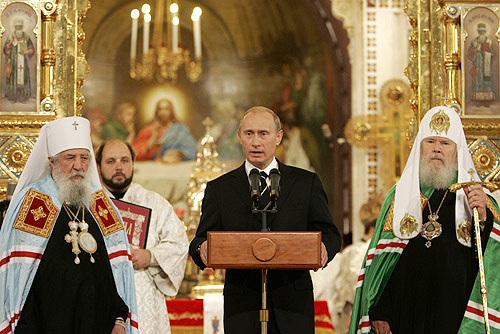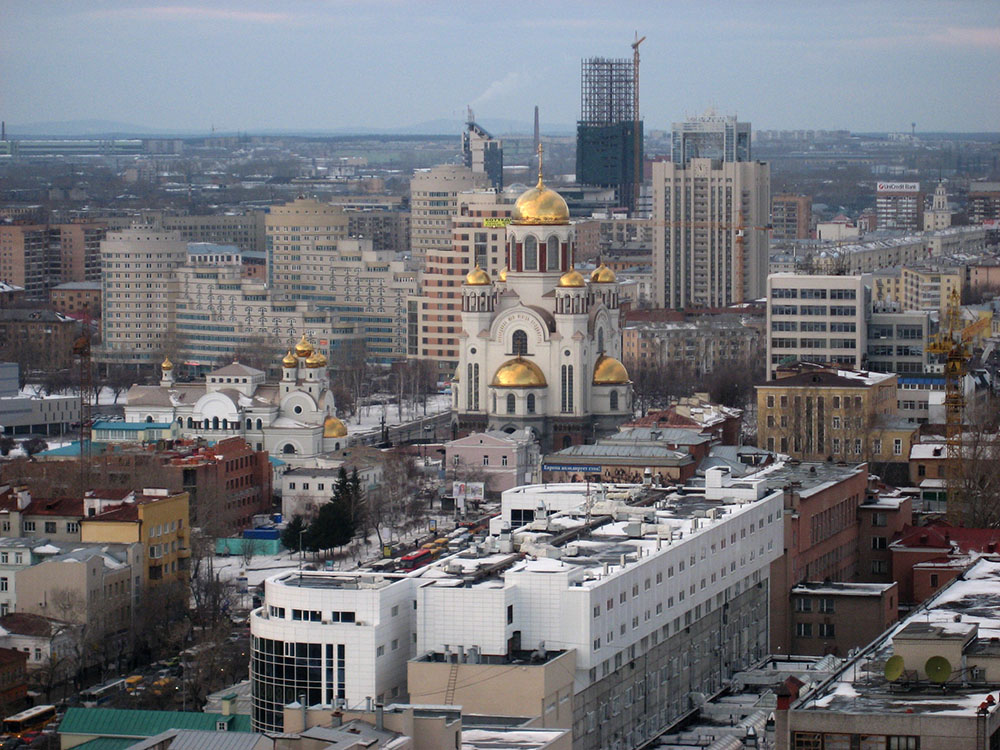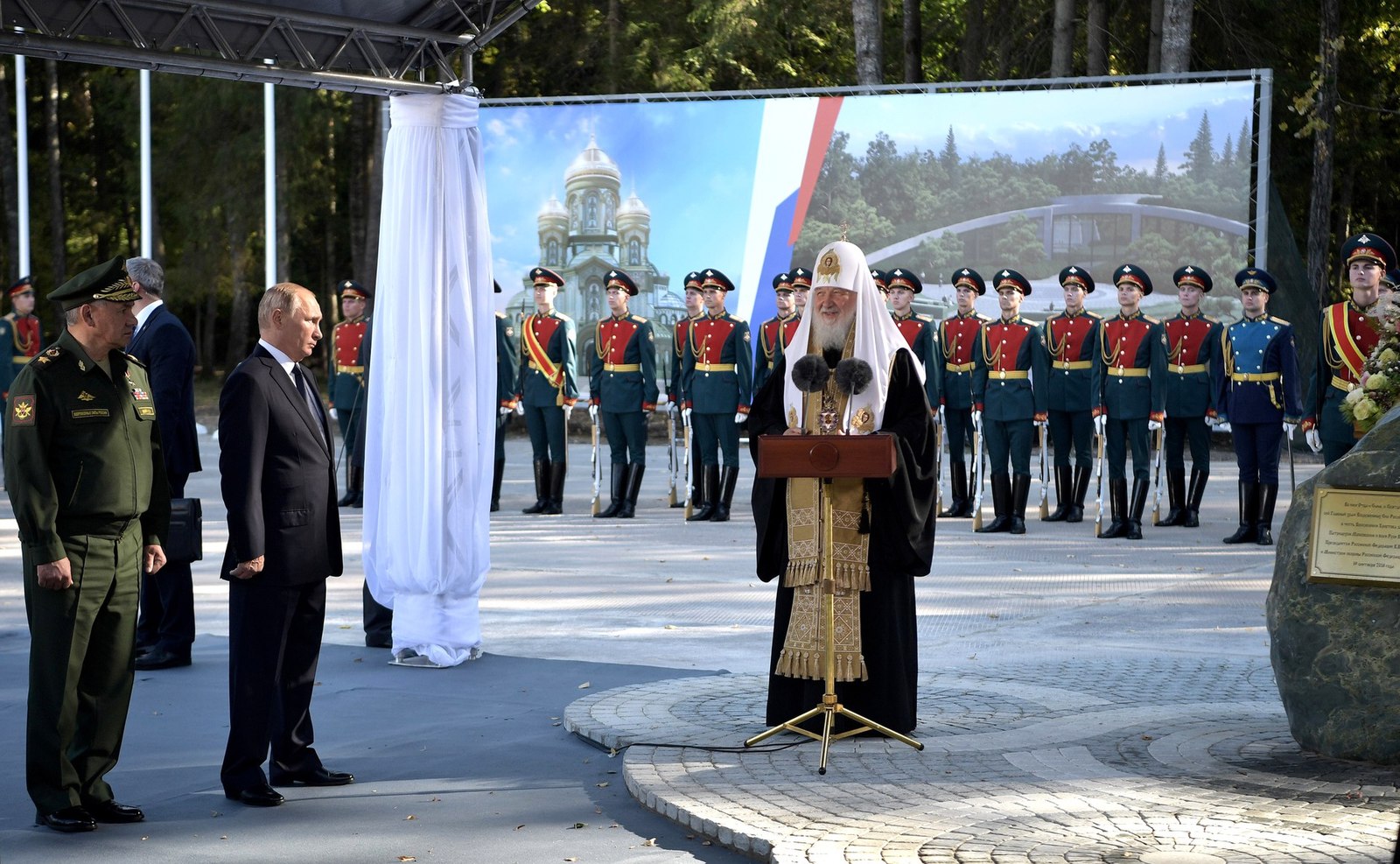Secular Policy, Ecclesiastical Practice: Church and State in Putin’s Russia
 President Vladimir Putin (centre) during the ceremony of signing the Act of Canonical Communication.
https://commons.wikimedia.org/wiki/File:Vladimir_Putin_Alexey_and_Laurus.jpg
President Vladimir Putin (centre) during the ceremony of signing the Act of Canonical Communication.
https://commons.wikimedia.org/wiki/File:Vladimir_Putin_Alexey_and_Laurus.jpg
Russia’s citizenry is paying a high price for President Vladimir Putin’s close relationship with the Russian Orthodox Church (ROC). Their public spaces are being transformed into religious institutions, legislation influenced by Russian Orthodox officials, and government partnering with the Orthodox establishment to retain power behind the backs of voters. Though the Russian Government rarely pursues a secularist narrative, it is officially secular under its constitution. Yet, the ROC holds a prestigious place in the Kremlin, and Putin’s relationship with the church appears to be one of mutual endorsement.
This past spring, residents of Yekaterinburg voiced their frustration with the government’s proposal to build yet another church, replacing a rare riverside park. The proposal was part of the ‘200 Church Program’, an act to further the already overwhelming influence of the ROC in civil and political life. The ROC and state relationship has been a swinging pendulum. Orthodoxy was considered integral to ‘Russification’, the process of homogenizing the ethnic and religious diversity of the 19th-century Russian Empire’s inhabitants. Comparatively, atheism was aggressively promoted throughout the Soviet era in an effort to rid the political climate of any potential counterrevolutionary institutions. Religious institutions were seen as yet another bourgeois tool to exploit the proletariat and therefore needed to be dismantled. With religiously reinvigorated Christianity coming to the forefront at the brink of the 21st-century, Russia’s state-ROC relationship is steadily strengthening.

Religion in the Soviet Union
As the Bolsheviks assumed power in 1917, a “nationwide campaign” to delegitimize religious tradition ensued in the quest for “godless communism”—the platform of Vladimir Lenin’s regime. Citizens saw houses of worship destroyed, priests and other religious authorities executed, and the closing of all religiously affiliated institutions. Upon the death of Patriarch Tikhon in 1925, the atheist mission could fully take flight. There was no election for a replacement patriarch as the government believed religion had no place in communist life. Religion had been integral to daily life during the time of its destruction. Tsardom had oriented Russian society around the foundations and teachings of the ROC. Much of the population in 20th century Russia was “illiterate peasantry” whose cultural and spiritual life was grounded in Orthodoxy. With the imposition of religious delegitimization, they lost a significant cultural identity.
The beginning of the dissolution of the Soviet system, otherwise known as the ‘perestroika’ period, allowed the younger demographic to engage in nonconformism. In the context of an atheist-promoting society, nonconformism manifested as engagement with religious practice. Nonconformists participated in church services, fasting, and praying in an effort to oppose atheist government doctrine. However, this youth-religion “romance” quickly dissolved as perestroika developed. Religious officials only knew the conservative practices of the previous centuries and failed to adapt to a modernizing and secularizing world.
The Russian Orthodox Church and the Russian Nation-State
Many ROC clergy have supported the idea that some scholars define as ‘Symphonia’: Church and state harmony. Symphonia intends to represent “internal cohesion of one single human society,” with the governing body responsible for human affairs and the clergy responsible for spiritual matters. Though, ROC leaders engage in a constant struggle with what this harmonious relationship entails in a 21st-century context, especially with Putin using the ROC as a political tool and thus bringing it into the government apparatus. With the re-introduction of religion upon the end of the Soviet era, the relevance of the ROC in governmental affairs, the mission of the ROC, and the meaning of liturgy went unaddressed. The role of the ROC in this new political sphere was left wildly ambiguous—a perfect condition for Putin’s later manipulation for political benefit.
Between 1994 and 2000, Patriarch Kirill, the then-chairman of ROC foreign relations, founded the document Foundations of the Social Conceptions of the Russian Orthodox Church. In terms of church-state relations, the document was to explicitly outline the boundaries of the ROC in social and political life. Establishing church-state cooperation proved difficult with the diversity of political positions among the clergy, ranging from liberalism to nationalist fundamentalism. Religious restriction brewed resentment among religiously affiliated peoples. Consolidating the new role of the ROC allowed for these repressed individuals to express their most radical envisions for the future of their societal sector. Ultimately, the document established that the ROC could engage in international and domestic peacekeeping, yet could not support waging civil or external war, and election agitation.

The Russian Orthodox Church and Vladimir Putin
The ROC-State relationship is separate from Putin’s personal—and highly political—relationship to Patriarch Kirill, the primary representative of the ROC. Putin enlisted the support of spiritual figures in his 2012 election campaign, staunchly challenging the claim that the ROC operates outside of the electoral realm. According to jailed political activists, the ROC became a pawn in a “dirty election campaign.” This political endorsement was no secrecy like those involved may have intended; it resulted in anti-Putin riots referencing and criticizing the ROC and its role in his victory. Consequently, Putin criminalized insulting religious beliefs, further emphasizing the mutual loyalty between Putin and the ROC.
While the ROC continues to claim its separation from political affairs, it remains a dominant policy influencer. Members engage in dialogue with public authorities to develop various laws and regulations. Consequently, daily life in Russia has an Eastern Orthodox flavour. Together, Putin and the ROC have targeted LGBT communities and dismantled abortion rights across the country in the name of traditional Christian values.
Putin has rationalized his promotion of the ROC through attacks on the morality of western societies. He argues that the west is morally corrupt, and their liberal values—such as LGBT rights—are the path to degradation. Therefore, he portrays himself and the ROC as protectors to Russian societal traditionalism—an ideal Putin sees as the key to a prosperous nation. Patriarch Kirill further plays into this narrative. He aims to illustrate the relationship as positive considering how the Russian people “know what it’s like to live without God,” and the loss of a cultural identity that accompanied the USSR’s militant atheism. This partnership calls back to Tsar Nicholas I and his triad of ‘Orthodoxy, Autocracy, Nationality’. He stressed the value of the ROC as a protector from western influence, and strengthening a national identity intimately tied to Eastern Orthodoxy. With Putin’s rhetoric, we see a mirror reflection of this infamous triad that was used to justify absolute power over the Russian people.
Putin continues to emphasize the need for God in Russian society, in his words and in his negotiations with the ROC. However, it’s important to note that Putin’s encouragement of religious growth through the promotion of the ROC is not without political benefit. As of February 2016, Russia had 34,764 parishes. With the 200 Church Program, this number has only been increasing. Though protests for new church construction are popping up across the country, the level of ROC influence is increasingly resembling its status in the days of the Russian Empire. Though Yekaterinburg protests aren’t anti-religious as the ROC accuses them of being, in light of their opposition one could argue that they have anti-ecclesiastical underpinnings in the face of religionization. Their anti-ecclesiastical nature is not explicitly a sentiment to the ROC itself, but the ROC as what citizens see as a proxy for Putin and his assertion of power.
Featured Image by the President of the Russian Federation, licensed under CC by 4.0
Edited by Elizabeth Hurley
